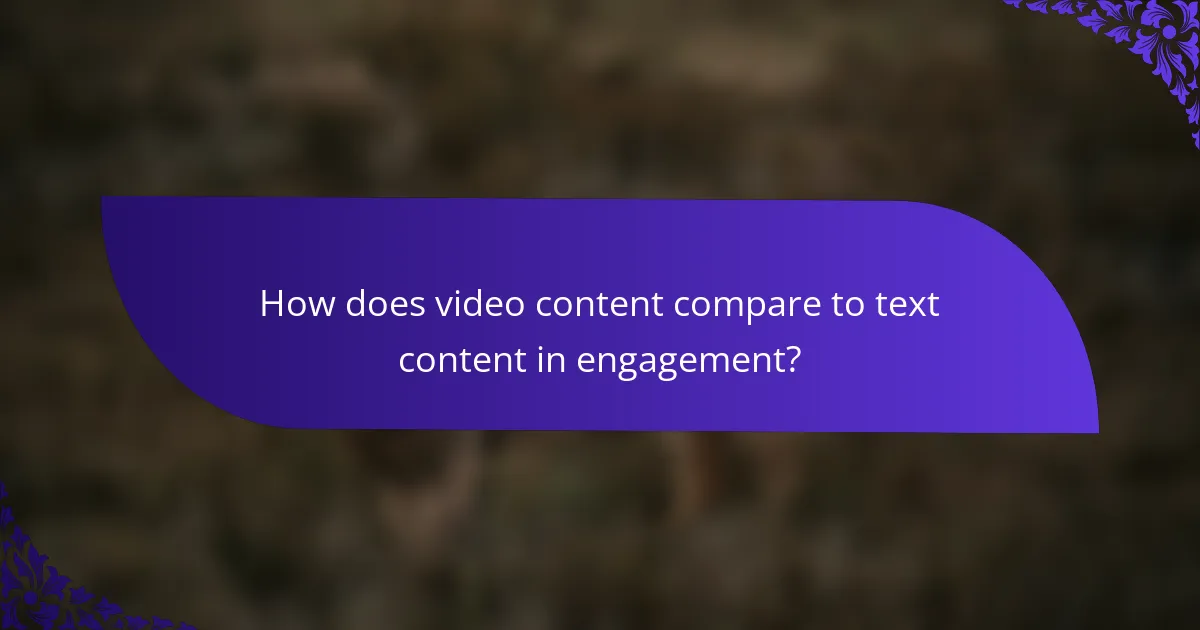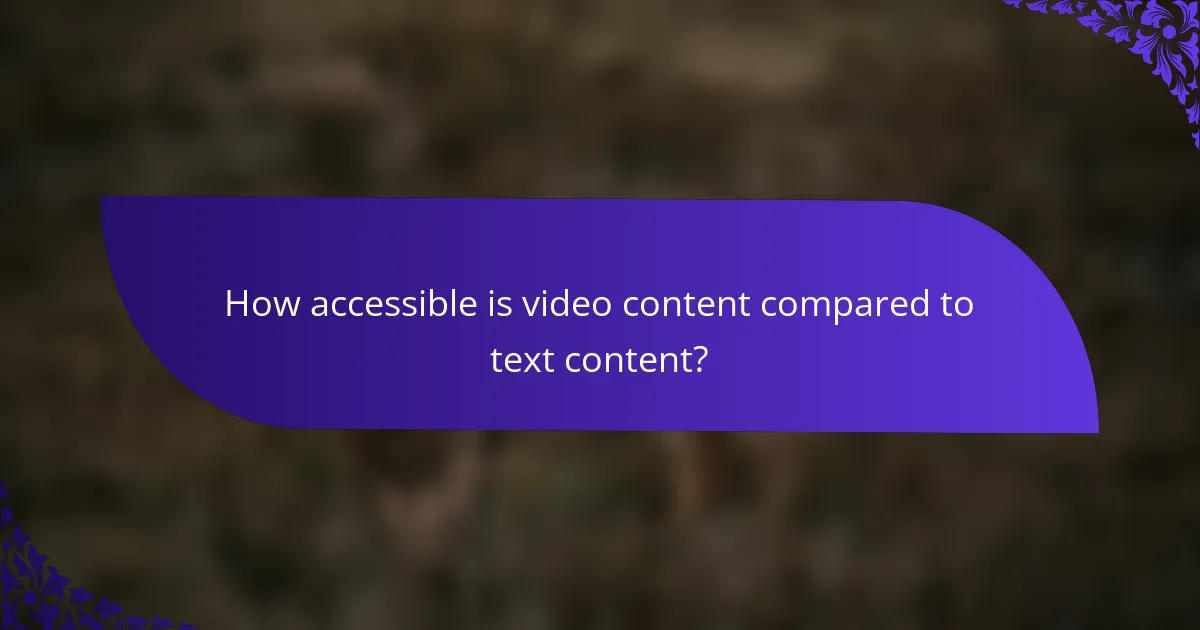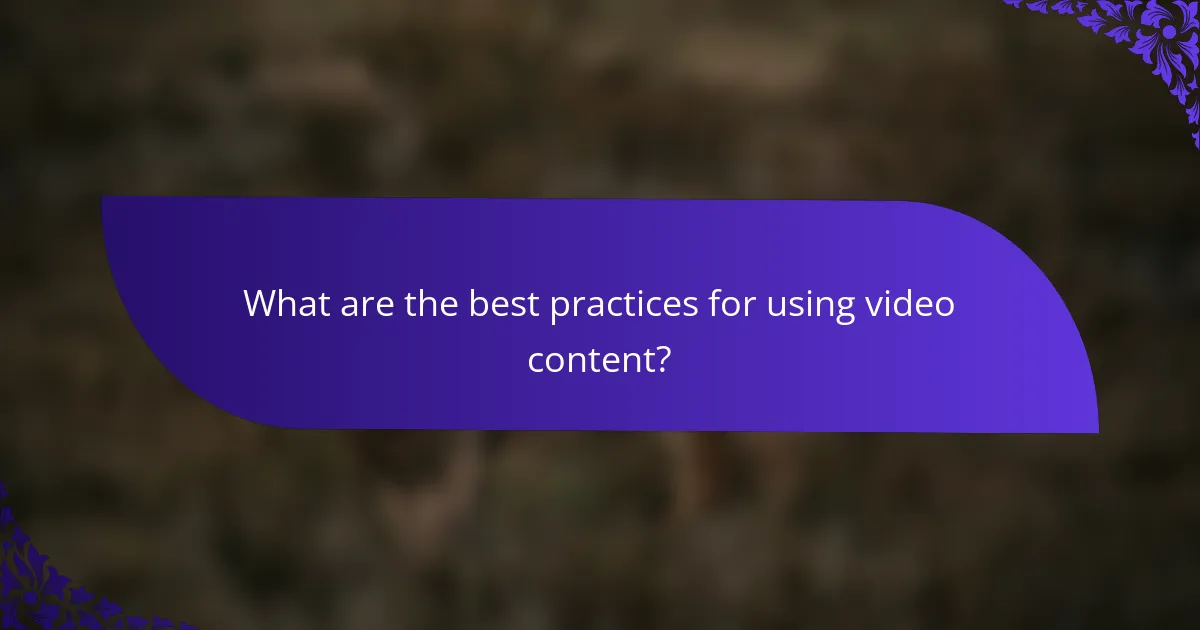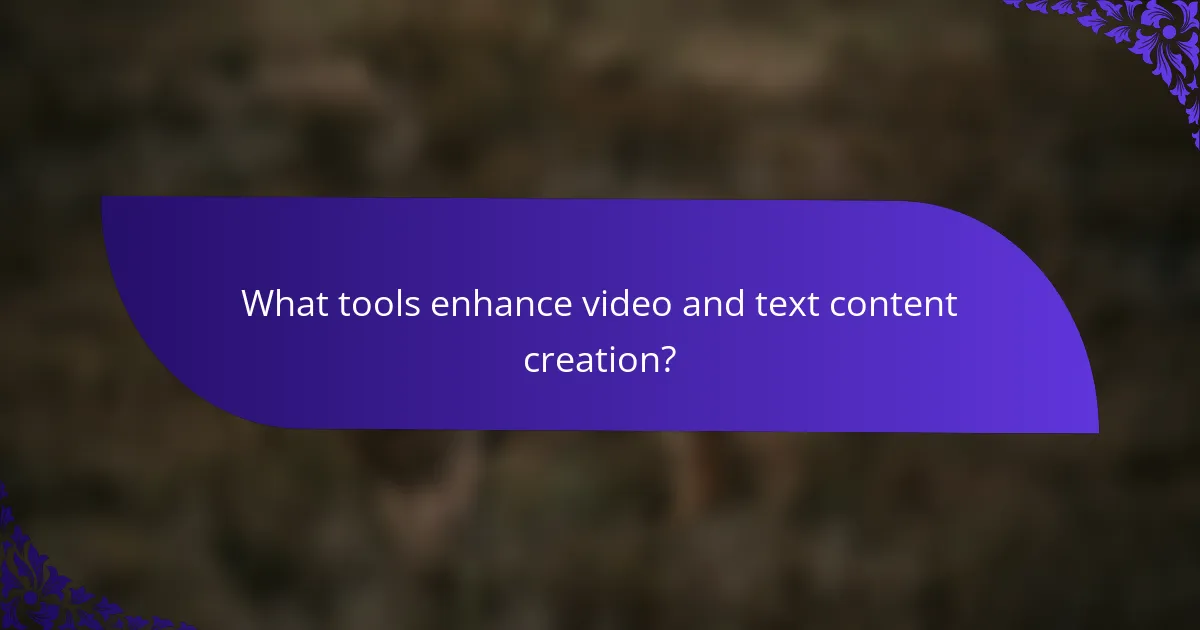In the digital landscape, video content often outperforms text in terms of engagement and retention, captivating audiences with its dynamic visual and auditory elements. While videos can hold viewers’ attention longer, they also present challenges in accessibility, requiring more resources and stable internet connections that may not be available to all users. Understanding these differences is crucial for content creators aiming to maximize their reach and impact.

How does video content compare to text content in engagement?
Video content generally achieves higher engagement levels than text content due to its dynamic nature and ability to convey information visually and audibly. Viewers often find videos more stimulating, which can lead to longer viewing times and increased interaction.
Higher viewer engagement rates with video
Videos tend to capture attention more effectively than text, resulting in higher viewer engagement rates. Research indicates that audiences are more likely to watch a video to completion compared to reading an entire article, especially when the video is well-produced and relevant.
For example, social media platforms often report that video posts receive significantly more likes, shares, and comments than text-based posts. This trend highlights the importance of incorporating video into content strategies to maximize audience interaction.
Text content’s effectiveness in niche audiences
While video excels in general engagement, text content can be more effective for niche audiences seeking in-depth information. Text allows for detailed explanations and complex ideas that may not be easily conveyed through video.
For instance, technical articles or academic papers often serve specialized audiences better through written content, as they provide the necessary depth and precision. When targeting specific groups, consider using text to deliver comprehensive insights that resonate with their interests.

What are the retention rates for video versus text content?
Retention rates for video content are generally higher than for text content, with videos often holding viewers’ attention for longer periods. This difference can be attributed to the engaging nature of visual storytelling compared to written material.
Video content retains attention longer
Video content typically captures and maintains audience attention more effectively than text. Studies suggest that viewers may stay engaged with video for several minutes, often exceeding the retention time for written articles. This is particularly true for dynamic and visually appealing videos that incorporate storytelling elements.
For example, educational videos or tutorials can keep viewers focused for 5 to 10 minutes, while text articles may only retain attention for a few minutes at most. The combination of visuals, sound, and narrative in videos creates a more immersive experience, which can enhance retention.
Text content’s retention varies by complexity
The retention of text content largely depends on its complexity and the reader’s familiarity with the subject. Simple, straightforward articles tend to have better retention rates, while complex or dense texts may lead to decreased engagement. Readers often skim through text, which can result in lower retention overall.
For instance, a well-structured blog post with clear headings and bullet points can retain attention more effectively than a lengthy academic paper. To improve retention for text content, consider using concise language, engaging visuals, and clear formatting to make the material more accessible.

How accessible is video content compared to text content?
Video content generally requires more resources for accessibility compared to text content. While videos can enhance engagement, they often depend on stable internet connections and compatible devices, which can limit access for some users.
Video requires more bandwidth and technology
Videos typically demand higher bandwidth, which can be a barrier for users with slow internet connections. Streaming quality can vary significantly based on available bandwidth, often requiring at least a few megabits per second for smooth playback.
Additionally, users need specific technology to access video content, such as smartphones, tablets, or computers with updated software. This can exclude individuals who rely on older devices or lack access to modern technology.
Text is universally accessible
Text content is inherently more accessible as it can be consumed on virtually any device with minimal requirements. Users can read text on smartphones, e-readers, or even printed materials without needing high-speed internet or advanced technology.
Moreover, text can be easily adapted for various needs, such as screen readers for visually impaired users or translated into multiple languages. This flexibility makes text a preferred choice for reaching a broader audience.

What are the best practices for using video content?
To maximize the effectiveness of video content, focus on creating engaging, concise, and accessible videos that cater to your audience’s preferences. Prioritize quality and clarity to enhance viewer retention and interaction.
Short, engaging videos for social media
Short videos, typically ranging from 15 to 60 seconds, are ideal for social media platforms where attention spans are limited. Aim to capture interest within the first few seconds to encourage viewers to watch until the end.
Utilize eye-catching visuals and compelling storytelling to create an emotional connection with your audience. Incorporating a clear call to action can also drive engagement, prompting viewers to share or comment on your content.
Incorporating captions for accessibility
Adding captions to your videos improves accessibility for viewers who are deaf or hard of hearing, as well as those who prefer to watch without sound. Captions can increase viewer retention by allowing users to follow along more easily.
Ensure that captions are synchronized accurately with the audio and are easy to read. Consider using a contrasting color for text and a background that enhances visibility. This practice not only broadens your audience but also aligns with accessibility standards, making your content more inclusive.

What are the best practices for using text content?
Effective text content should be structured clearly and optimized for search engines to enhance engagement and retention. By focusing on readability and SEO techniques, you can ensure your text reaches and resonates with your target audience.
Clear structure and formatting for readability
A clear structure is essential for making text content easily digestible. Use headings, subheadings, and bullet points to break up large blocks of text, allowing readers to scan for key information quickly. Aim for short paragraphs, ideally no more than three to four sentences each, to maintain reader interest.
Consider using a consistent font size and style, along with adequate spacing between lines and sections. This improves overall readability, especially on mobile devices where screen space is limited. Tools like readability checkers can help ensure your content is accessible to a broad audience.
SEO optimization techniques for text
SEO optimization is crucial for increasing the visibility of your text content in search engine results. Start by conducting keyword research to identify relevant terms that your audience is searching for. Incorporate these keywords naturally into your text, including in headings and subheadings, to improve search rankings.
Additionally, use meta descriptions and alt text for images to enhance your SEO strategy. Aim for concise, compelling meta descriptions that summarize your content effectively, as these can influence click-through rates. Regularly updating your content and ensuring it is relevant can also positively impact your SEO performance.

How do audience preferences vary by demographic?
Audience preferences for content types vary significantly across different demographics, particularly between younger and older groups. Understanding these preferences can help creators tailor their content strategies effectively.
Young audiences prefer video content
Young audiences, particularly those in their teens and twenties, show a strong preference for video content. This demographic is often drawn to platforms like TikTok, YouTube, and Instagram, where engaging visuals and dynamic storytelling capture their attention.
Video content tends to hold the interest of younger viewers for longer periods, often exceeding single-digit minutes. Creators should focus on short, impactful videos that convey messages quickly and entertainingly to maximize engagement.
Older demographics favor text content
Older demographics, typically those over thirty-five, often favor text-based content, such as articles and blog posts. This group tends to appreciate in-depth information and analysis, which text formats can provide more effectively than video.
Text content allows older audiences to consume information at their own pace, making it easier to digest complex topics. When targeting this demographic, consider using clear headings, bullet points, and concise paragraphs to improve readability and retention.

What tools enhance video and text content creation?
Several tools can significantly enhance the creation of video and text content, improving both quality and efficiency. Utilizing specialized software can streamline the editing process, optimize text for readability, and ultimately boost audience engagement.
Adobe Premiere Pro for video editing
Adobe Premiere Pro is a leading video editing software that offers a comprehensive suite of tools for professionals and enthusiasts alike. It supports various formats and provides features like multi-camera editing, color correction, and audio mixing, making it suitable for creating polished video content.
When using Premiere Pro, consider the learning curve; it may take some time to master its advanced features. However, the investment is worthwhile for high-quality production. Start with basic edits and gradually explore more complex functionalities as you become comfortable.
Grammarly for text content optimization
Grammarly is a powerful tool designed to enhance text content by checking grammar, punctuation, and style. It provides real-time feedback, helping writers produce clear and engaging content that resonates with their audience.
To maximize Grammarly’s effectiveness, use it not only for proofreading but also for improving tone and readability. The premium version offers advanced suggestions, which can be particularly beneficial for professional writing. Regularly reviewing suggestions can help develop better writing habits over time.

What are the emerging trends in content consumption?
Emerging trends in content consumption show a significant shift towards video over text, driven by user preferences for engaging and easily digestible formats. As technology advances, platforms are adapting to provide more interactive and visually appealing content to meet audience demands.
Video Content Engagement
Video content is increasingly favored for its ability to capture attention quickly and convey information effectively. Users tend to engage more with videos, spending longer periods watching them compared to reading text. This trend is particularly evident on social media platforms, where short-form videos dominate user interactions.
To maximize engagement, consider using eye-catching thumbnails and compelling narratives. Incorporating elements like subtitles can also enhance viewer retention, making videos accessible to a broader audience, including those with hearing impairments.
Text Content Retention
While video captures attention, text content remains crucial for detailed information and in-depth analysis. Readers often prefer text for topics requiring thorough understanding, as it allows for easier skimming and referencing. However, retention rates for text can vary significantly based on formatting and clarity.
To improve retention, use clear headings, bullet points, and concise paragraphs. Engaging visuals can complement text, breaking up long sections and maintaining reader interest. Aim for a balance between informative content and readability to keep your audience engaged.
Accessibility Considerations
Accessibility is a vital aspect of content consumption, impacting how diverse audiences engage with video and text. Video content should include captions and audio descriptions to accommodate viewers with disabilities. Text content should be formatted for screen readers and include alternative text for images.
Adhering to accessibility standards, such as the Web Content Accessibility Guidelines (WCAG), ensures that your content is usable by everyone. Regularly testing your content with accessibility tools can help identify areas for improvement, making your material more inclusive and effective.


